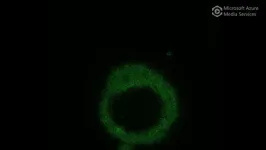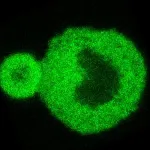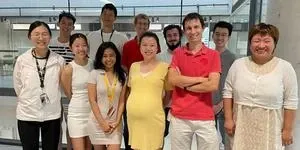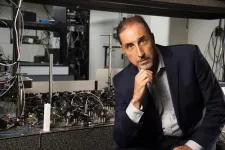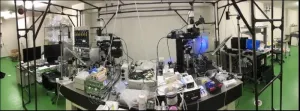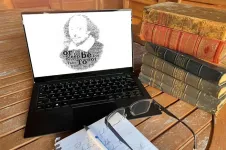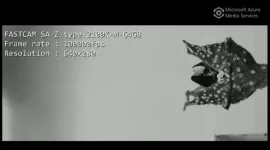(Press-News.org) Many diseases affecting the brain and nervous system are linked to the formation of protein aggregates, or solid condensates, in cells from their liquid form condensate, but little is known about this process.
This liquid-to-solid transition can trigger the formation of what are called amyloid fibrils. These can further form plaques in neurons causing neurodegenerative diseases such as Alzheimer's.
Biomedical engineers at the University of Sydney, in collaboration with scientists at the University of Cambridge and Harvard University, have now developed sophisticated optical techniques to monitor at close range the process by which these protein aggregates form.
By testing a protein associated with Amyotrophic Lateral Sclerosis – ALS disease, which affected astrophysicist Professor Stephen Hawking – the Sydney engineers closely monitored the transition of this protein from its liquid to solid phase.
“This is a huge step forward to understanding how neurogenerative diseases develop from a fundamental perspective,” said Dr Yi Shen, lead author of the research published in the Proceedings of the National Academy of Sciences (PNAS) in the United States.
“We can now directly observe the transition of these critical proteins from liquid to solid at the nanoscale – a millionth of a metre in scale,” said Dr Daniele Vigolo, a senior lecturer in the School of Biomedical Engineering and a member of the University of Sydney Nano Institute.
Proteins regularly form condensates during liquid-to-liquid phase separation in a wide range of critical and healthy biological functions, such as the formation of human embryos. This process assists biochemical reactions where protein concentrations are critical and also promotes healthy protein–protein interactions.
“However, this process also increases the risk of dysfunctional aggregation, where unhealthy aggregates of solid proteins form in human cells,” said Dr Shen, who is an ARC DECRA Fellow in the School of Chemical and Biomolecular Engineering and also a member of Sydney Nano.
“This can lead to aberrant structures associated with neurodegenerative diseases because the proteins no longer exhibit rapid reversibility back to liquid form. It is therefore crucial to monitor condensate dynamics, as they directly affect pathological states,” she said.
The world-first nanoscale optical observation of this process has allowed the team to determine that the transition from liquid to solid protein starts at the interface of the protein condensates. This window onto the phase transition also revealed that the internal structures of these protein agglomerates are heterogenous, where previously they were thought to be homogeneous.
Dr Vigolo said: “Our findings promise to greatly improve our understanding of neurogenerative diseases from a fundamental perspective.
“This means a promising new area of research to better understand how Alzheimer’s disease and ALS develops in the brain, affecting millions of people worldwide.”
### ends ###
DOWNLOAD photos and a short video of the condensate process at this link.
YouTube: short clip of condensate interaction at this link.
INTERVIEWS
Dr Daniele Vigolo Dr Yi Shen
School of Biomedical Engineering School of Chemical and Biomolecular Engineering
Faculty of Engineering Faculty of Engineering
The University of Sydney The University of Sydney
daniele.vigolo@sydney.edu.au yi.shen@sydney.edu.au
MEDIA ENQUIRIES
Marcus Strom | +61 423 982 485 | marcus.strom@sydney.edu.au
DECLARATION
The authors declare no competing interests.
This work is supported by the Newman Foundation, the Wellcome Trust, ERC, US Alzheimer Association Zenith, ALS Canada–Brain Canada, Canadian Institutes of Health Research and the Cambridge Centre for Misfolding Diseases. Canadian Institutes of Health Research, Alzheimer Society of Ontario Chair in Alzheimer’s Disease Research; US National Institute of Aging. Researchers acknowledge the Cambridge Advanced Imaging Centre and K.H. Muller for help with flash-freezing and SEM imaging.
END
When proteins get stuck at solid: unlocking the secrets to brain diseases
Nanoscale view of proteins opens window to treat neurodegenerative illness
2023-08-24
ELSE PRESS RELEASES FROM THIS DATE:
NPS professor’s DURIP award will take quantum research to new heights
2023-08-24
Naval Postgraduate School (NPS) Professor Dr. Frank Narducci, Chair of the Department of Physics, received a Defense University Research Instrumentation Program (DURIP) award to build what could become the most precise atomic instrument of its kind for applications to quantum sensing experiments in navigation and timekeeping.
Called an atomic tower, the instrument is expected to have unprecedented sensitivity to acceleration and rotation measurements due to its unprecedented height. NPS research utilizing this instrument has many applications of interest to the Department of the Navy, Narducci explained.
“Most immediately ...
Griffith on the cusp of a new vaccine modality breakthrough
2023-08-24
Griffith University researchers are on the brink of a technological breakthrough in vaccine development with a possible new vaccine modality.
Professor Bernd Rehm and Dr Shuxiong Chen from the Griffith Institute for Drug Discovery (GRIDD) and Griffith’s Centre for Cell Factories and Biopolymers have succeeded in developing a new vaccine modality that is a stable particulate vaccine.
The new vaccine modality is at proof-of-concept stage and in early development.
To demonstrate this vaccine approach, it was tested with a more established Griffith vaccine against Strep A that is currently performing strongly in human clinical trials in Canada.
Professor ...
Do measurements produce the reality they show us?
2023-08-24
Whenever the precision of a measurement approaches the uncertainty limit defined by quantum mechanics, the outcomes of the measurement depend on the dynamics of the interactions with the meter used to determine a physical property of the system. This finding may explain why quantum experiments often produce conflicting results and may contradict basic assumptions regarding physical reality.
Two quantum physicists from Hiroshima University recently analyzed the dynamics of a measurement interaction, where the value of a physical property is identified with a quantitative change in the meter state. This is a difficult problem, because quantum theory does not identify the value ...
The mouse metaverse: A tool for understanding the molecular mechanism of autism and the mind
2023-08-24
Autism is difficult to study and more difficult to treat because it is an individual condition lacking precise quantification. The development of mouse models of human mental disorders has proven a tractable approach to studying the molecular mechanisms, a new review argues and highlights the current state of the art in autism research.
Whether or not the autism spectrum is a disorder to be treated or a disability to be accommodated is debated by experts. This, however, is symptomatic for the fact that it is a very individual condition that has many expressions as well as causes, with no quantitative evaluation system or objective, mechanized diagnostic method. This makes ...
New ‘verbal treasure trove’ dictionary captures nuances and uses of Shakespeare’s words
2023-08-24
William Shakespeare used the word dotage to capture reduced mental ability (as in being blindly in love) rather than as a quaint term for old age, successes were really outcomes – one could talk of a ‘bad success’ – and, it turns out, the word bastard back then most often referred to a flower that was genetically hybrid.
A new dictionary, a verbal treasure trove of the nuances and uses of Shakespeare’s words, is published this week.
While dinner was preferred by Shakespeare for what we might think of as lunch (although his contemporaries used it to refer to an evening meal), beef, as today, was strongly associated with the English, but particularly the lower ...
Breast cancer study altered guidelines in Sweden
2023-08-24
BRCA1 and BRCA2 are well-known breast cancer genes associated with a significantly increased risk of hereditary breast and ovarian cancer. However, there are an additional eleven genes associated with elevated risk for these types of cancer. A multi-year Swedish study now reveals that the proportion of women with genetically confirmed hereditary breast cancer doubled by including all genes in the screening test.
In a Swedish research study including patients between 2012 and 2018, all cancer genetic clinics in Sweden participated. A total of 4759 individuals underwent comprehensive ...
Researchers to probe brain mechanisms behind free will
2023-08-24
Picture this scenario: You and a friend are walking around your neighborhood when you stop at a crosswalk. As you wait, the noises of the world and your internal thoughts all vie for your attention. Suddenly, you see a motorist nearly hit a bicyclist.
“Whoa, did you see that?” you say to your friend.
“I sure did; that was a fully restored 1967 Ford Mustang,” your friend replies, referring to a car separate from the near-traffic collision.
Despite being in the same place at the same time, and looking at the same scene, you and your friend paid attention to different things.
Why? ...
Blink and you'll miss these plants shooting their seeds
2023-08-24
DURHAM, N.C. -- If you happened upon a witch hazel plant in the forest, you might describe it as a sweet-smelling shrub with crinkly ribbon-like petals. But to Duke University graduate student Justin Jorge, it’s a howitzer.
That’s because of the impressive firepower of its fruits.
When witch hazels are ready to disperse their seeds, their woody seed capsules split open. Pressure builds up, and eventually the seeds shoot out like bullets fired from a rifle, hitting 30 feet per second in about half a millisecond.
“If you blink you’ll miss it,” said Jorge, who worked on this project as part of his Ph.D. thesis in biomechanics with senior author ...
Could microplastics in soil introduce drug-resistant superbugs to the food supply?
2023-08-24
URBANA, Ill. — Like every industry, modern farming relies heavily on plastics. Think plastic mulch lining vegetable beds, PVC pipes draining water from fields, polyethylene covering high tunnels, and plastic seed, fertilizer, and herbicide packaging, to name a few. In a new review article, University of Illinois Urbana-Champaign researchers say these plastics are now widely dispersed in agricultural soils in the form of microplastics and nanoplastics.
That’s not necessarily new; microplastics have been found in nearly every ...
Heavy drinking, handgun-carrying linked among rural youth
2023-08-24
In the rural United States, an adolescent who drinks heavily has a 43% greater probability of carrying a handgun in the following year, according to a study published this month in The Journal of Rural Health.
“While there has been a lot of research on this correlation in urban areas, little is known about the association between alcohol use, particularly heavy drinking, and handgun carrying in rural areas,” said lead author Alice Ellyson, an acting assistant professor of pediatrics at the University of Washington School of Medicine and investigator in UW Medicine's Firearm Injury & Policy Research Program.
“Our study ...
LAST 30 PRESS RELEASES:
Palaeontology: Ancient tooth suggests ocean predator could hunt in rivers
Polar bears may be adapting to survive warmer climates, says study
Canadian wildfire smoke worsened pediatric asthma in US Northeast: UVM study
New UBCO research challenges traditional teen suicide prevention models
Diversity language in US medical research agency grants declined 25% since 2024
Concern over growing use of AI chatbots to stave off loneliness
Biomedical authors often call a reference “recent” — even when it is decades old, analysis shows
The Lancet: New single dose oral treatment for gonorrhoea effectively combats drug-resistant infections, trial finds
Proton therapy shows survival benefit in Phase III trial for patients with head and neck cancers
Blood test reveals prognosis after cardiac arrest
UBCO study finds microdosing can temporarily improve mood, creativity
An ECOG-ACRIN imaging study solves a long-standing gap in metastatic breast cancer research and care: accurately measuring treatment response in patients with bone metastases
Cleveland Clinic presents final results of phase 1 clinical trial of preventive breast cancer vaccine study
Nationally renowned anesthesiology physician-scientist and clinical operations leader David Mintz, MD, PhD, named Chair of the Department of Anesthesiology at the UM School of Medicine
Clean water access improves child health in Mozambique, study shows
Study implicates enzyme in neurodegenerative conditions
Tufts professor named Fellow of the National Academy of Inventors
Tiny new device could enable giant future quantum computers
Tracing a path through photosynthesis to food security
First patient in Arizona treated with new immune-cell therapy at HonorHealth Research Institute
Studies investigate how AI can aid clinicians in analyzing medical images
Researchers pitch strategies to identify potential fraudulent participants in online qualitative research
Sweeping study shows similar genetic factors underlie multiple psychiatric disorders
How extreme weather events affect agricultural trade between US states
Smallholder farms maintain strong pollinator diversity – even when far from forests
Price of a bot army revealed across hundreds of online platforms worldwide – from TikTok to Amazon
Warblers borrow color-related genes from evolutionary neighbors, study finds
Heat signaling from plants is an ancient pollinator signal
New index reveals the economics underlying the online manipulation economy
High-resolution satellite observations reveal facility-level methane emissions worldwide
[Press-News.org] When proteins get stuck at solid: unlocking the secrets to brain diseasesNanoscale view of proteins opens window to treat neurodegenerative illness
